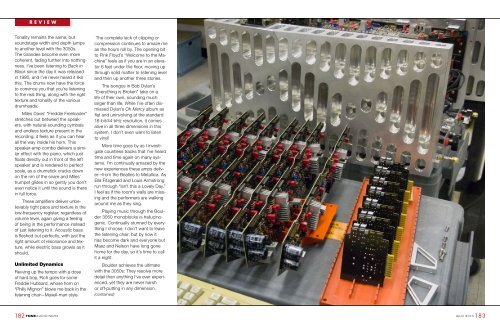Create successful ePaper yourself
Turn your PDF publications into a flip-book with our unique Google optimized e-Paper software.
182<br />
REVIEW<br />
Tonality remains the same, but<br />
soundstage width and depth jumps<br />
to another level with the 3050s.<br />
The Grandes become even more<br />
coherent, fading further into nothingness.<br />
I’ve been listening to Back in<br />
Black since the day it was released<br />
in 1980, and I’ve never heard it like<br />
this. The drums now have the force<br />
to convince you that you’re listening<br />
to the real thing, along with the right<br />
texture and tonality of the various<br />
drumheads.<br />
Miles Davis’ “Freddie Freeloader”<br />
stretches out between the speakers,<br />
with natural-sounding cymbals<br />
and endless texture present in the<br />
recording; it feels as if you can hear<br />
all the way inside his horn. This<br />
speaker-amp combo delivers a similar<br />
effect with the piano, which just<br />
floats directly out in front of the left<br />
speaker and is rendered to perfect<br />
scale, as a drumstick cracks down<br />
on the rim of the snare and Miles’<br />
trumpet glides in so gently you don’t<br />
even notice it until the sound is there<br />
in full force.<br />
These amplifiers deliver unbelievably<br />
tight pace and texture in the<br />
low-frequency register, regardless of<br />
volume level, again giving a feeling<br />
of being in the performance instead<br />
of just listening to it. Acoustic bass<br />
is fleshed out perfectly, with just the<br />
right amount of resonance and texture,<br />
while electric bass growls as it<br />
should.<br />
Unlimited Dynamics<br />
Revving up the tempo with a dose<br />
of hard bop, Rich goes for some<br />
Freddie Hubbard, whose horn on<br />
“Philly Mignon” blows me back in the<br />
listening chair—Maxell-man style.<br />
TONE AUDIO NO.54<br />
The complete lack of clipping or<br />
compression continues to amaze me<br />
as the hours roll by. The opening bit<br />
to Pink Floyd’s “Welcome to the Machine”<br />
feels as if you are in an elevator<br />
6 feet under the floor, moving up<br />
through solid matter to listening level<br />
and then up another three stories.<br />
The bongos in Bob Dylan’s<br />
“Everything is Broken” take on a<br />
life of their own, sounding much<br />
larger than life. While I’ve often dismissed<br />
Dylan’s Oh Mercy album as<br />
flat and uninvolving at the standard<br />
16-bit/44-kHz resolution, it comes<br />
alive in all three dimensions in this<br />
system. I don’t even want to listen<br />
to vinyl!<br />
More time goes by as I investigate<br />
countless tracks that I’ve heard<br />
time and time again on many systems.<br />
I’m continually amazed by the<br />
new experiences these amps deliver—from<br />
the Beatles to Metallica. As<br />
Ella Fitzgerald and Louis Armstrong<br />
run through “Isn’t this a Lovely Day,”<br />
I feel as if the room’s walls are missing<br />
and the performers are walking<br />
around me as they sing.<br />
Playing music through the Boulder<br />
3050 monoblocks is hallucinogenic.<br />
Continually stunned by everything<br />
I choose, I don’t want to leave<br />
the listening chair, but by now it<br />
has become dark and everyone but<br />
Maez and Nelson have long gone<br />
home for the day, so it’s time to call<br />
it a night.<br />
Boulder achieves the ultimate<br />
with the 3050s: They resolve more<br />
detail than anything I’ve ever experienced,<br />
yet they are never harsh<br />
or off-putting in any dimension.<br />
(contained)<br />
April 2013 183




